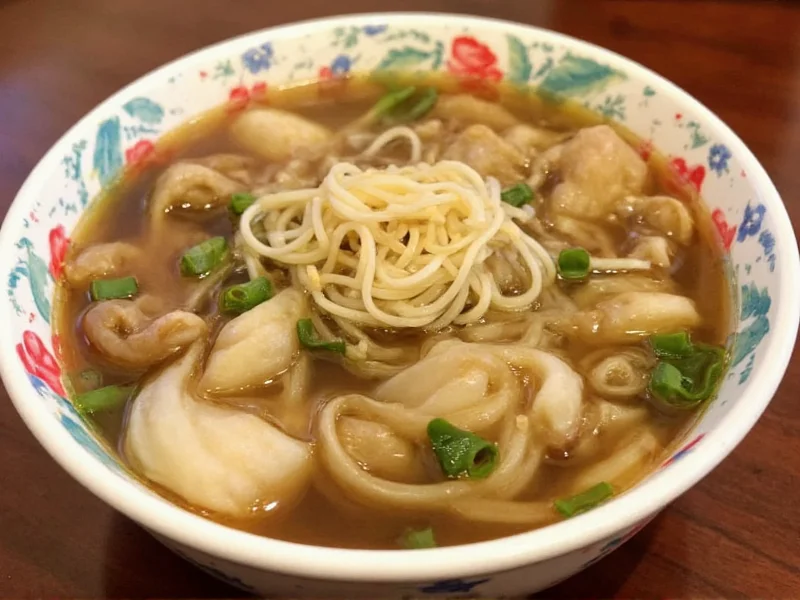Wonton soup, a beloved staple in Chinese cuisine, offers more than just comforting warmth—it delivers a balanced nutritional profile that can fit into various dietary patterns when prepared thoughtfully. Understanding the exact nutritional facts of traditional wonton soup helps health-conscious eaters make informed choices whether dining out or preparing this dish at home.
Breaking Down Wonton Soup Nutrition
When evaluating the calorie content of wonton soup, it's essential to consider the components separately. The broth, wontons themselves, and any additional ingredients each contribute differently to the overall nutritional value.
| Nutrient | Amount per 1 Cup (240ml) | % Daily Value* |
|---|---|---|
| Calories | 100-150 | 5-8% |
| Protein | 5-8g | 10-16% |
| Total Fat | 2-4g | 3-5% |
| Saturated Fat | 0.5-1.5g | 3-8% |
| Carbohydrates | 10-15g | 4-5% |
| Dietary Fiber | 0-2g | 0-8% |
| Sodium | 600-1,000mg | 26-43% |
*Percent Daily Values based on a 2,000 calorie diet. Values may vary significantly based on preparation.
Factors That Influence Nutritional Value
The nutritional composition of homemade wonton soup differs substantially from restaurant versions. Several key factors affect the final nutritional profile:
Broth Type Matters
Traditional wonton soup uses a clear broth, but the base significantly impacts nutrition:
- Chicken broth: Typically lower in fat but may contain 700-900mg sodium per cup
- Pork broth: Richer flavor but contains slightly more fat (3-5g per cup)
- Vegetable broth: Lowest in calories (80-100 per cup) but often lacks the protein content of meat-based broths
Wonton Filling Variations
The filling inside wontons dramatically affects the protein content in wonton soup:
- Pork wontons: Higher in fat (4-6g per 3-4 wontons) but excellent protein source
- Shrimp wontons: Leaner option with 6-8g protein and only 1-2g fat per serving
- Vegetable wontons: Lowest in calories but also lower in protein (2-3g per serving)
Health Benefits and Considerations
Wonton soup offers several nutritional advantages when prepared with attention to ingredients. The health benefits of wonton soup include:
Hydration and Digestion
The broth base provides hydration while the warm liquid can aid digestion. Adding vegetables like bok choy or spinach increases fiber content, supporting gut health and making the soup more filling without substantially increasing calories.
Sodium Content Awareness
One of the most significant nutritional concerns with wonton soup is sodium content. Restaurant versions often contain 800-1,200mg sodium per serving—nearly half the recommended daily limit. For those monitoring sodium levels in wonton soup, homemade versions allow for better control, potentially reducing sodium by 30-50%.
Protein-Packed Comfort Food
Compared to many comfort foods, wonton soup delivers meaningful protein. The combination of meat-filled wontons and broth provides complete protein that helps maintain muscle mass and promotes satiety. This makes it a better choice than many high-carb, low-protein alternatives when considering healthy wonton soup nutrition facts.
Comparing Wonton Soup to Other Asian Soups
Understanding how wonton soup fits within Asian soup options helps contextualize its nutritional value compared to other Chinese soups:
| Soup Type | Calories (1 cup) | Protein (g) | Sodium (mg) |
|---|---|---|---|
| Wonton Soup | 100-150 | 5-8 | 600-1,000 |
| Egg Drop Soup | 80-120 | 3-5 | 700-1,100 |
| Hot and Sour Soup | 120-180 | 4-6 | 900-1,300 |
| Miso Soup | 35-60 | 2-3 | 400-700 |
Wonton soup generally offers better protein content than egg drop or miso soup while maintaining moderate calorie levels. However, hot and sour soup often contains more sodium due to additional seasonings.
Creating Healthier Wonton Soup
Whether making homemade wonton soup with balanced nutrition or ordering wisely at restaurants, these strategies optimize nutritional value:
At Home
- Use low-sodium broth or make your own to control salt content
- Add extra vegetables like spinach, mushrooms, or bok choy for fiber and nutrients
- Choose shrimp or lean pork fillings for wontons
- Limit wonton quantity to 3-4 per serving to manage calories
When Dining Out
- Request broth on the side to control sodium intake
- Ask for extra vegetables and fewer wontons
- Choose clear broth versions over creamy or heavily seasoned options
- Avoid versions with added noodles which significantly increase carbohydrate content
Wonton Soup in Dietary Context
For those following specific eating patterns, understanding how wonton soup fits is crucial:
Weight Management
The moderate calorie count and protein content make wonton soup a satisfying option for weight management. A standard serving provides enough substance to prevent hunger without excessive calories—ideal as a starter or light meal.
Low-Sodium Diets
Individuals on sodium-restricted diets should seek low-sodium versions or prepare homemade wonton soup using reduced-sodium ingredients. The low sodium wonton soup nutritional profile can be significantly improved with careful preparation.
Protein Requirements
For active individuals or those focusing on muscle maintenance, wonton soup provides quality protein. Pairing it with a side salad or steamed vegetables creates a balanced meal meeting approximately 15-20% of daily protein needs.











 浙公网安备
33010002000092号
浙公网安备
33010002000092号 浙B2-20120091-4
浙B2-20120091-4